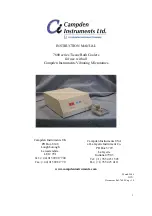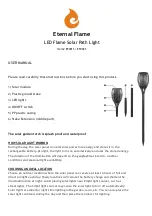
DANLERS Limited, Vincients Road, CHIPPENHAM, Wiltshire, SN14 6NQ, UK.
Telephone: +44 (0)1249 443377 Fax: +44 (0)1249 443388 E-mail: [email protected]
www.danlers.co.uk
Company Registered Number 2570169 VAT Registration Number 543 5491 38
DAT008
9
CEFLPIR
11/11/2020
PLEASE READ THESE INSTRUCTIONS BEFORE INSTALLING THE PRODUCT
DANLERS ceiling flush passive infra-red
occupancy switches (PIR) can be flush
mounted into suspended and plasterboard
ceilings (diagram A). They include a 2 metre
connecting flex to make installation quicker
and easier.
DIAGRAM A
Clearance
hole 63mm or
64mm (2.5")
diameter
Springs can either be
left closed (down the
side of the product)
or opened out.
These PIR switches incorporate a passive
infra-red quad sensor to detect movement
of a warm body within their detection zone
(diagram B) and a photocell to monitor the
ambient light level.
up to 5m
up to 7m
Strong detection zone
i.e. person moving
arm or walking
towards PIR
Secondary detection
zone i.e. person
walking perpendicular
to PIR
For optimum coverage recommended
mounting height: 2.4 to 5m
DIAGRAM B (DETECTION)
Upon detecting movement, if the ambient
light is dark enough, the PIR switch will turn
the load on. The ambient threshold can be
set by the user to between approximately
30 lux and 1000 lux and maximum
(photocell inactive) at the PIR via the LUX
adjuster (diagram C).
If no more movement is detected within a
pre-selected time, then the PIR switch will
turn the load off. This time lag can be set
via the TIME adjuster to 10 seconds, 20
seconds, 40 seconds, 80 seconds,
2 minutes 30 seconds, 5 minutes,10
minutes, 20 minutes or 40 minutes
(diagram C).
INSTALLATION PROCEDURE
1. Please read these notes carefully before
commencing work. In case of doubt
please consult a qualified electrician.
2. POSITIONING: The PIR occupancy
switch (PIR) should be installed to achieve
correct coverage of the area, see diagram
B. If the photocell override facility is
required, the switch must be located
above an area where daylight can give
greater illumination than the artificial light.
Avoid locating this product where it is
exposed to draughty conditions (exposed
lobbies, open ceiling voids or near fans)
or near heat sources. To cover large
areas PIRs should be spaced in a 5 metre
grid formation.
3. The greatest energy savings will be
achieved if each PIR controls an
independent set of lamps. They can be
wired in parallel but this should ideally be
limited to three, see diagram E.
4. Make sure the power is isolated from the
circuit. The PIR should be connected as
shown in diagrams D & E:
Brown: L (Live in). Blue: N (Neutral in).
Black: SL(Switched Line out).
NOTE: Terminate the mains cable with the supplied
terminal block (terminal blocks must comply with EN
60998-1 or EN 60998-2-1 and be suitable for 0.75-
1.5mm2 conductors). In order to comply with wiring
regulations, the terminal block must be enclosed in
a suitable wiring box (This should comply with EN
60670-1 or EN 60670-22).
LOADING
See overleaf for loading details.
START-UP MODE
When the PIR is powered up, the PIR will
switch on the lighting load for 1 minute then
switch it off. After 2 seconds it will switch
on again if it detects movement. With Time
set to minimum the load will stay on for 10
seconds so the detection range can be
easily assessed. If a manual override-off
switch is positioned before the PIR in the
circuit (diagrams D & E, note 1) it will do this
each time the wall switch is switched on.
Alternatively, if the wall switch is placed after
the PIR (diagrams D & E, note 2) it will not
enter the start-up mode each time.
TIME AND LUX SET UP
For convenience, ensure that the TIME is
set to the minimum when setting up the
LUX level. Afterwards set the TIME to a
value suitable for the application.
The LUX is best set up when the local
CEFL PIR
Ceiling Flush Mounted
PIR Occupancy Switch
(Presence detection)
Input: 220-240 Vac 50Hz
ambient light is at approximately the
minimum desired working light level, a lux
meter placed on the surface under the PIR
may help. With the LUX set fully clockwise
wait for the PIR to switch off. Rotate the
LUX adjuster slowly anticlockwise (- to +),
whilst waving your hand approximately 1m
below the PIR, until the load switches on.
TIME
min
max
LUX
max
min
Typical settings
30 LUX
1000 LUX
PHOTOCELL
INACTIVE
40m
20m
10m
5m
2.5m
80s
10s
20s
40s
DIAGRAM C (ADJUSTING TIME AND LUX)
TROUBLESHOOTING
The load will not switch on:
• The LUX adjuster is set too low and is
inhibiting the switch.
• The moving body is not emitting more
IR than the background. (Person
wearing insulating clothing in a warm
environment)
• Person is too far from the PIR switch, see
detection diagram.
• Person is moving unusually slowly
(perhaps when testing).
The load switches on when nobody is
present:
• Heater causing infra-red variations in a
small cold room. Re-site the CEFL PIR.
• Please contact DANLERS for further
technical support.
VARIANTS - MAINS VOLTAGE
CEFLPPIR
Includes a Klik-AX plug.
CEFLPIR10A
Up-rated to switch 10A
resistive loads.
CEFLPIRSEALED Suitable for bathrooms
zones 2 and 3.
CEFLAPIR
Flush mounted PIR
absence switch




















